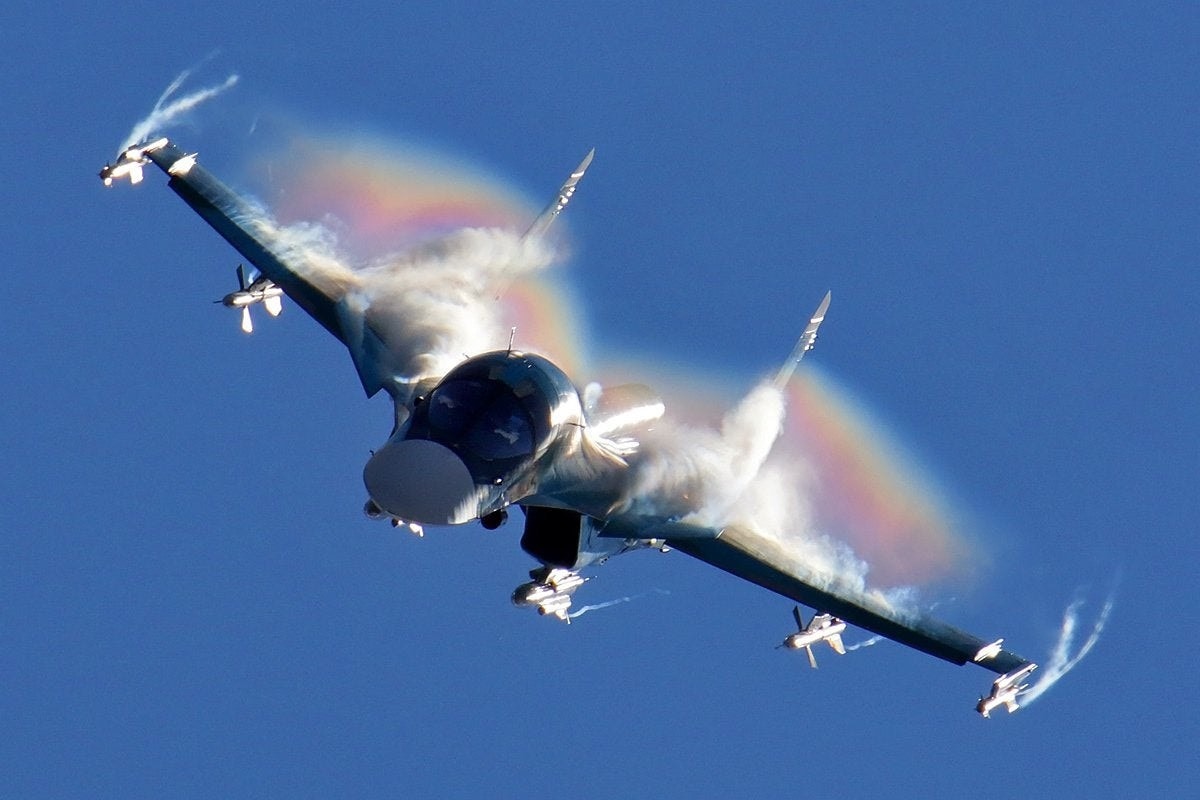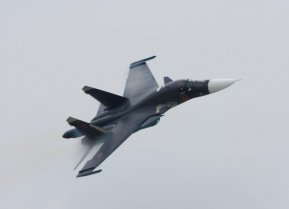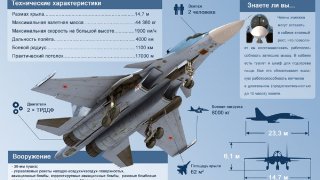Russia's Su-34 'Fullback' Is a Killer In the Sky
It wouldn't be an overstatement to suggest that the Su-34 was one of the best aircraft to come out of the Soviet Union during the late Cold War period.
Russia's Su-34 Fullback is One of Its Most Capable Aircraft - Developed during the latter stages of the Cold War, the Sukhoi Su-34 (NATO reporting name "Fullback") took its first flight in 1990 and was originally intended for service with the Soviet Air Forces.
As with many other late Soviet-era programs, it was put on the proverbial "back burner" with the collapse of the Soviet Union and then remained in limbo during Russia’s economic crisis that followed. The program was only revived in earnest in the early 2000s, with eight pre-production aircraft built for trials and evaluations.
It formally entered service in 2014 – although there are reports that it was employed during the Russo-Georgia War of 2008. Approximately 155 have been manufactured, including the prototypes and serial-produced aircraft.
Su-34: Saving the Best For Last?
It really wouldn't be an overstatement to suggest that the Su-34 was one of the best aircraft to come out of the Soviet Union during the late Cold War period. The twin-seat, all-weather supersonic medium-range aircraft was designed to serve as a fighter-bomber and strike aircraft.
Originally designated the Su-27IB, it was based on the Sukhoi Su-27 (NATO reporting name "Flanker"), and was developed primarily for a strike/attack role to replace the Su-24 (NATO reporting name "Fencer") attack fighter and Tupolev Tu-22 (NATO reporting name "Blinder") bomber with a single platform.
The Su-34's surface design includes a duckbill-shaped nose cone, two tail fins broadly reminiscent of the Su-27, canards to assist with maneuverability, and a side-by-side cockpit that can potentially facilitate improved communication between the two pilots.
It has since been noted to be one of Russia's most capable all-weather combat aircraft – able to conduct ground, surface, and air attacks. It had been deployed to Syria, where it was employed in attacks against rebel and ISIS forces, and could likely be used to help defend Moscow's interests in the Arctic region.
The Su-34 is powered by a pair of Saturn AL-31FM1 turbofan engines, the same engines used on the Su-27SM, giving the aircraft a maximum speed of Mach 1.8+ when fully loaded. When equipped with a full weapons load, the Su-34 has a maximum range of 4,000 km (2,500 mi; 2,200 nmi), or further with aerial refueling. It is further equipped with counter-fire and electronic warfare (EW) counter-measures systems.
The fighter-bomber features a modern glass cockpit, with color multi-function displays, while its nose section accommodates a suite of advanced multi-mode phased array radar, capable of terrain following. The cockpit and some other crucial components and systems are reported to be armored, and the Su-34 is fitted with comprehensive electronic countermeasures equipment. The Su-34 further has a rearward facing radar and can launch air-to-air missiles at pursuing enemy aircraft.
It is armed with a 30 mm GSh-301 cannon with 180 rounds, and the aircraft is equipped with 10 underwing and under-fuselage hardpoints for a wide range of weapons, including air-to-air, air-to-surface, anti-ship and anti-radiation missiles, guided or free-fall bombs.

The Su-34 typically carries 4,000 kg of weapons, while the maximum capacity is 8,000 kg.
Its primary air-to-air weapon is the R-77 (AA-12) missile, with two R-73 (AA-11 or Archer) short-range air-to-air missiles carried on wingtip rails. For ground and naval strike roles, the Russian fighter-bomber can be armed with long-range standoff weapons, including the Kh-55, Kh-59, Kh-59M, Kh-25, Kh-29 air-to-surface missiles, Kh-31, Kh-35, Kh-41 Moskit, and P-800 Oniks anti-ship missiles, and Kh-58 anti-radiation missiles.
Modernized Su-34s
While many of its internal components were on the edge of obsolescence, the design went through a thorough refit and modernization. The result was a more than capable two-seat, supersonic Generation 4+ strike fighter aircraft – even if some of the design elements were introduced when U.S. President Ronald Reagan was in office.
There have been reports that the Kremlin has developed two versions – one for electronic warfare, equipped with an L700 Tarantul ECM pod that can provide electronic cover for a group of aircraft; and another for intelligence, surveillance, and reconnaissance (ISR) missions.

Combat Use in Ukraine
The Su-34 has seen service with the Russian Air Force in the ongoing conflict in Ukraine. As of this past May, there have been 20 visually confirmed cases of Su-34s being lost, damaged or abandoned by Russian forces, according to the open-source intelligence site Oryx. The first was lost just days after Moscow launched its unprovoked invasion.
The Kremlin has confirmed the loss of more than ten Su-34s.
In October, the Russian Ministry of Defense (MoD) announced that a "second batch" of new Su-34 aircraft had been manufactured at the Novosibirsk Chkalov Aviation Plant of the United Aircraft Corporation (UAC, part of Rostec State Corporation) and handed over to the Russian Ministry of Defense.
"Our aircraft makers are successfully fulfilling the most important task of providing the Russian Ministry of Defense with new high-performance aircraft systems," Vladimir Artyakov, First Deputy Director General of Rostec State Corporation said in a statement. "The Su-34 aircraft has proven itself to the troops, and obligations to supply these aircraft under the state defense order are being fulfilled in full and in a timely manner."
This follows a previous batch that was announced at the end of May of this year. However, it is unclear exactly how many aircraft were in each batch.
Author Experience and Expertise
Peter Suciu is a Michigan-based writer. He has contributed to more than four dozen magazines, newspapers, and websites with over 3,200 published pieces over a twenty-year career in journalism. He regularly writes about military hardware, firearms history, cybersecurity, politics, and international affairs. Peter is also a Contributing Writer for Forbes and Clearance Jobs. You can follow him on Twitter: @PeterSuciu.
Image Credit: All Images Creative Commons.


